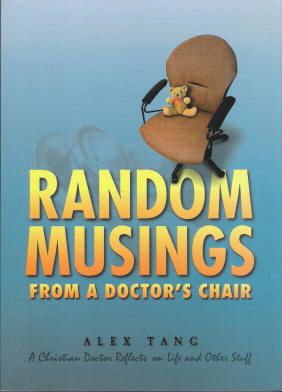Influencers of Spiritual Formation in Malaysia (4)
Influencers of Spiritual Formation in Malaysia (4)
Religious Pluralism in Multicultural Malaysia
Religious pluralism in a multicultural society is another spiritual formation influencer. The Star, one of Malaysia’s English newspaper has this report entitled “Holy Friday for Malaysia” dated Saturday 7 April 2007:
“It was a Holy Friday for Malaysians as they headed for the churches, temples, shrines and mosques yesterday. While Muslims converged for the Friday prayers, Christians attended Good Friday masses, devotees of Kuan Yin (celebrating her birthday) thronged temples while Hindus prayed to Lord Ganesha, the elephant-headed God to remove all obstacles.” (2007,N3)
Christianity has to coexist with Islam, Confucianism, Buddhism, Taoism, Sikhism, Hinduism, Bahai’ism, and many indigenous tribal religions in multi-racial Malaysia. Each of these religions have their sacred books, their traditions, their civilisations which may be thousands of years old, and each claim to be the one true religion.
How are the Christians to respond in such a situation?
There have been a number of options in which Christians are responding to religious pluralism. The commonest is withdrawal into a religious ghetto. Here we isolate ourselves from the demands of other religions, limiting our interactions with practitioners of other religions, and reserve our interactions with Christians alone. The second option is to start a crusade and by violence make Christianity the dominant religion and wiping out all other religions. Where once practised elsewhere in Christian history, that is not an option in Malaysia. The third option is to re-examine our theology to see if there are room for other faith to come in. Rienzie Perera research director of Life & Peace Institute, Sweden presented a paper, Religions, Cultures and Peace: The Challenge of Religious Pluralism and the Common Life in Asia, at the Asian Conference on Church and Society in 1999. He mentioned that Christians need to re-examine three theological statements if they are to deal adequately with religious pluralism in Asia. “They are: outside the Church no remission of sin, outside Jesus no salvation, and outside the Scriptures no revelation of God.” (italics author’s)(1999, 113). It should not be heretical to re-examine these doctrines but should be “a distinctively Asian contribution to Third World theologies, that of rethinking Christian faith within the parameters of religious pluralism.” (Parratt 2004, 9-11). Song, professor of theology in the South East Asia Graduate School of Theology comments,
“Let us be clear, then, that it is not our business to protect the truth. Rather it is our business to serve the truth, wherever and whenever it is found…God’s salvation can no longer be explained in terms of a history moving forward along a straight line. To explain God’s salvation this way is to explain it away. God moves in all directions: God moves forward, no doubt, but also sideways, and even backwards. Perhaps God zigzags too. It does not seem God's interest to create neat and tidy landscapes in certain selected places. God goes anywhere a redeeming presence is called for- in Asia, in Africa, as well as in Israel and in the West.” (Song 1985, 17-18)
There is a great need to develop Third world theologies that will adequately address this problem of religious pluralism in the various Third world countries. With increasing migration, religious pluralism will be an issue in the First world in the coming years. The fourth option is to deal minimally with other religions while maintaining our doctrinal purity. Albert Vun, an Anglican priest advises, “The challenge is to modify ethical behaviour so as not to give any occasion for stumbling to the church of God nor to create hindrances to the not-yet-believing to accept the gospel.” (Vun 1992, 32) The final option is to engage in dialogue with the other religions[1]. This dialogue will deal with common grounds, with the intention to learn from one another. Yap Kim Hao, the first Asian Bishop of the Methodist Church in Malaysia and Singapore, comments,
"Therefore, dialogue does not demand the avoidance of differences or the suspension of theological convictions. It is not a polite refusal of facing up to the essential things that divide us. Experience in dialogue reveals that the dialogue partners are very much interested in the differences of theological convictions. They are eager to try to understand the other person’s faith and beliefs even though they are contradictory to their own cherished ideas and practices. It is within the setting of dialogues that we witness to one another of our faith. We are called to approach with honesty and integrity”. (Yap 1990, 109)
The aim is to find ways to co-exist with tolerance and harmony through dialogue.
The Malaysian Chinese Presbyterian churches have adopted a spiritual ghettos mentality in response to the religious pluralism in the country. There are no attempts to reach out or dialogue with other religious groups. The ghetto mentality is another spiritual formation influencer in the Presbyterian churches.
Malaysia is a multi-cultural country. Therefore it is essential that the different races be able to live in peace with one another. Unfortunately, two myths continue to threaten the harmony of the relationship between the majority Malays and the Chinese. Wang Gung Wi, Director of the East Asian Institute, National University of Singapore writes,
“Two myths have survived to continue to endanger communal trust between Malays and Chinese: that of the wealthy Chinese and that of the lazy Malays. They have bedevilled the economic and educational developments of the country since independence in 1957. The wealthy Chinese myth has led to economic policies which appear blatantly discriminatory to the Chinese and seem to ignore the fact that the majority of Chinese are poor. The lazy Malay myth has coloured Chinese explanations of Malay failures in both education and commerce and made the Chinese discontented with the highly protectionist New Economic policy of he government.” (Wang 2001, 273)
Unfortunately the Malaysia churches also subscribe to these myths. Instead of reaching out to each other, the Malaysian Christian tends to restrict contact with the other races at a business or government level. There is very little social mixing of the different racial groups. Believing the myths, angry at the discriminatory government measures, and fearful of being accused of evangelising, Malaysian Christians are having little contact with the Malays. This leads to further polarisation. This is a direct challenge to the Biblical teaching of loving your neighbours.
Bibliography
(2007). Holy Friday for Malaysians. The Star. Kuala Lumpur: N3.
Chang, L. S. (1999). Asia's Religions: Christianity's Momentous Encounter with Paganism. Canada, China Horizon and Horizon Ministries Canada.
Griffiths, B. (1976). Return to the Center. Springfield. IL, Templegate Publishers.
Hanh, T. N. (1995, 2007). Living Buddha, Living Christ. New York, Penguin Group (USA) Inc.
Kennedy, R. E. (1995). Zen Spirit, Christian Spirit: The Place of Zen in Chrisian Life. New York, The Continuum International Publishing Group.
Lama, D. (1996). The Good Heart: A Buddhist Perspective on the Teachings of Jesus. Sommerville, MA, Wisdom Publications.
Lim, D. and S. Spaulding, Eds. (2005). Sharing Jesus Holistically with the Buddhist World. Pasadena, CA, William Carey Library Publishers.
Lin, D. and S. Spaulding, Eds. (2003). Sharing Jesus in the Buddhist World. Pasadena, CA, William Carey Library.
Parratt, J., Ed. (2004). An Introduction to Third World Theologies. United Kingdom, Cambridge University Press.
Parshall, P. (1983). Bridges to Islam: A Christian Perspective on Folk Islam. Grand Rapids, MI, Baker Book House.
Robinson, B. (2004). Christians Meeting Hindus: An Analysis and Theological Critique of the Hindu-Christian Encounter in India. United Kingdom, Regnum Books International.
Song, C. S. (1985). Tell Our Names: Story Theology from an Asian Perspective. Indore, India, Satprakashan Sanchar Kendra.
Vun, A. (1992). The Challenge of Religious Pluralism: Some Preliminary Considerations. Readings in Malaysian Church & Mission. K. P. Goh. Petaling Jaya, Pustaka SUFES: 25-34.
Wang, G. W. (2001). Don't Leave Home: Migration and the Chinese. Singapore, Times Academic Press.
Yap, H. K. (1990). Doing Theology in a Pluralistic World. Singapore, The Methodist Bookroom.
Endnotes
[1] The Dalai Lama’s Buddhist-Christian dialogue is an excellent model of respectful dialogue, even though the Dalai Lama does not accept the deity of Jesus, nor the need of salvation. Lama, D. (1996). The Good Heart: A Buddhist Perspective on the Teachings of Jesus. Sommerville, MA, Wisdom Publications. Thich Nhat Hanh has a similar gentle approach. Hanh, T. N. (1995, 2007). Living Buddha, Living Christ. New York, Penguin Group (USA) Inc. Robert Kennedy who is a Jesuit is more syncretic in his approach. Kennedy, R. E. (1995). Zen Spirit, Christian Spirit: The Place of Zen in Chrisian Life. New York, The Continuum International Publishing Group.
Though the various authors in the next two books are mission minded, many of them did express in their writings respect suitable for a dialogue. It is difficult to have a dialogue if one party think that only he/she has the Truth and no one else. Lin, D. and S. Spaulding, Eds. (2003). Sharing Jesus in the Buddhist World. Pasadena, CA, William Carey Library. and Lim, D. and S. Spaulding, Eds. (2005). Sharing Jesus Holistically with the Buddhist World. Pasadena, CA, William Carey Library Publishers.
Bob Robinson provides a broad understanding of Christina-Hindu dialogue within a theological framework. Robinson, B. (2004). Christians Meeting Hindus: An Analysis and Theological Critique of the Hindu-Christian Encounter in India. United Kingdom, Regnum Books International. Bede Griffiths is still the best writer of the Christian-Hindu dialogue. Griffiths, B. (1976). Return to the Center. Springfield. IL, Templegate Publishers. Kenneth Cragg’s book is still the best for an introduction to the Muslim-Christian dialogue. His gentle approach and call for understanding, participation, retrieval, interpretation, hope, and faith is inspiring. Phil Parshall builds on Cragg’s approach but approaches from the direction of folk Islam, mysticism, and Sufism. Parshall, P. (1983). Bridges to Islam: A Christian Perspective on Folk Islam. Grand Rapids, MI, Baker Book House. Chang Lit Sen, a Chinese apologist, theologian, scholar in Asian philosophy and Distinguished Lecturer in Mission Emeritus in Gordon-Conwell Theological Seminary approaches inter-religious dialogue as a critic. Chang, L. S. (1999). Asia's Religions: Christianity's Momentous Encounter with Paganism. Canada, China Horizon and Horizon Ministries Canada.
Labels: Influencer, Spiritual Formation















2 Comments:
This is what I have been struggled for the past few years - How to evangelise to a pluralistic society like ours. I found it difficult not to be so dogmatic and not to claim that Jesus is THE WAY so that not to offend my friends who come from different faith. But, I can't help to find myself irritated when they do offerings to the idols, they claim their way is the truest way, they go and seek advise from fortune teller, believeing in incarnation and believing in superstitious practice which are false teachings in our perspective. This is even more irritating when this happened to my loved ones like my mum, dad, and sister. How do I do it in a gentle way and loving way so that they will know the True way and the rest are false? what are the practical steps ? I really run out of ideas. most of the time, when they talked about their religions, nowadays, I tend to avoid and shut my ear when I feel the irritations and prayed for they will know the truth.
hi chee keat,
I can understand your frustrations. I guess we need to continue to dialogue with them and live out our incarnational life with them. And then trust the Lord to work.
Shalom
Post a Comment
<< Home